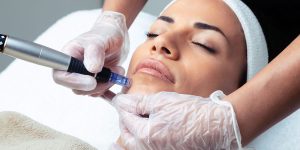Melasma and various methods of its treatment

Melasma is one of the most serious skin discolourations, which may be caused by hormonal changes, pregnancy or certain diseases. Let’s get to know the effective treatments of aesthetic medicine Poznań, which will allow you to effectively remove skin discolouration and help regain a young and natural look of the skin.
What is melasma and what are its causes?
Melasma (or chloasma) is discolouration caused by hormones, the sun and genes. They are most often felt during pregnancy or taking oral contraceptives. Melasma can be caused by autoimmune diseases (thyroid), the use of hormonal preparations or photosensitizing drugs and supplements. Melasma occurs on the forehead, cheeks and around the mouth and takes the form of diffuse brown spots.
Reduction of discolouration and melasma by means of a fractional laser
The fractional laser enables local treatment, and no wounds are formed during the procedure. The treatment progresses very quickly and the patient may return to his former functioning in a short time. All these benefits, combined with the effectiveness of the fractional laser, make it an important element in the treatment of skin discolouration reduction. The laser, thanks to the use of energy in the form of focused light beams, produces controlled micro damages in the skin, which lead to the replacement of damaged cells with healthy and renewed tissue.
Melasma – how to remove skin discolouration?
The fractional laser stimulates the epidermis and dermis to produce more collagen as the healing processes are triggered. The fractional laser not only reduces discolouration but also has a positive effect on skin lightening. Its additional effect is firming and rejuvenating.
The most effective is the neodymium YAG laser
Chemical peels that have a beneficial effect on reducing discolouration
In aesthetic medicine clinics in Poznań, chemical peels based on trichloroacetic, lactic and kojic acid are very often used in the treatment of skin discolouration. The effect of chemical peels is to reduce sun discolouration, get rid of molasses or other pigment changes. Thanks to the formula consisting of several broad-spectrum acids, the treatment is effective and painless. 1 to 5 treatments are enough to completely get rid of discolouration.
Melasma – how to remove skin discolouration? – Needle mesotherapy
In the case of discolourations that are difficult to remove, such as melasma, needle mesotherapy comes to the rescue. Mesotherapy affects the number of melanocytes, but also the process of melanin production in the skin. What does the needle mesotherapy treatment look like in aesthetic medicine Poznań? The doctor uses an injection to inject lightening substances under the skin, which contribute to the reconstruction of the skin.
Melasma (chloasma) is one of the most common discolourations found mainly in women. They usually appear after the age of 30. The role of the causative agents is not fully understood.
Clinical picture: irregular discolouration, sharply limited brown spots without signs of inflammation, located on the face (forehead, cheeks, upper lips). The symmetry of the foci makes it look like a mask. The most common form is symptomatic, occurring during pregnancy, during the use of hormonal contraceptives (chloasma uterine), drugs.
Treatment: consists of the use of decolorizing and exfoliating preparations. For discolouration, agents containing hydroquinone, kojic acid, azelaic acid, and retinoids are used. Decolorizing preparations are used both in combination and by the method of alternate applications. The exfoliation uses alpha-hydroxy acids, mainly glycolic acid and trichloroacetic acid.
There are two methods of exfoliation. In the former, lower concentrations of AHA are used chronically, often in combination with hydroquinone, hydroquinone in the latter, higher concentrations of AHA (70% glycolic acid) or 30% trichloroacetic acid. The beneficial effects of treatment are also obtained after laser therapy, mainly with a CO2 laser.
Protection against ultraviolet radiation should be the basis for the treatment of skin discolouration, regardless of the depigmentation methods used.






